The $450m New York Leonardo Salvator Mundi Part II: It Restores, It Sells, therefore It Is
ITEM 1: “Thomas Campbell, former director of the Metropolitan Museum of Art, held that while the price was ‘eye-popping, it should come as no surprise in a market where speculation, marketing and branding have displaced connoisseurship as the metrics of value’. Todd Levin, an art adviser, told the New York Times: ‘This was a thumping epic triumph of branding and desire over connoisseurship and reality.’” – The Guardian 16 November 2017
ITEM 2: “The freakish sale of the Leonardo work – or, according to the detractors, the remains of a historic picture very partially by Leonardo and very largely by the hand of skilled restorers – caused not only incredulity and amazement but also a sort of stunned revulsion. This, some people felt, was just too mad. It was perhaps the first inkling that a market that is undeniably exciting and exhilarating might be on the edge of becoming seriously troubling.” – “The $400m question”, Jan Dalley, the Financial Times, 9/10 December 2017
ITEM 3: “Questions about Salvator Mundi’s authenticity, quality, and physical state were no match for the drive to possess this singular trophy. The acquisition also uniquely encapsulated art’s evolving role in the manufacture of soft-power and negotiation of geopolitics.” – “The Year in Visual Culture”, an Artsy editorial, 22 December 2017 [emphasis added]
ITEM 4: “As Christie’s aggressively marketed Leonardo da Vinci’s Salvator Mundi before the work sold for an astonishing $450m last November, the art world raged anew with questions about the painting’s attribution– even though London’s National Gallery had largely settled the debate by including the work in its 2011-12 Leonardo show.” – Judith H. Dobrzynski, The Art Newspaper, January 2018 [emphasis added].
ITEM 5: “The painting Salvator Mundi will be shown at The National Gallery, London, exhibition: “Leonardo da Vinci: Painter of the Court of Milan” from 9 November 2011 – 5 February 2012.
Leonardo is known [sic] to have painted the Salvator Mundi – an image of Christ holding a globe, with his right hand raised in blessing. The version in a private collection in New York was shown after cleaning to the Director of the National Gallery and to the Curator of the exhibition as well as to other scholars in the field. We felt that it would be of great interest to include this painting in the exhibition as a new discovery. It will be presented as the work of Leonardo, and this will obviously be an important opportunity to test this new attribution by direct comparison with works universally accepted as Leonardo’s. A separate press release on the Salvator Mundi is issued by the owner.” – A National Gallery press statement, July 2011
ITEM 6: “By 1500 onwards, the period in which the painted panel is said to have been executed, for want of time, Leonardo produced few works. Fra Pietro da Novellara, who visited his studio in April 1501, reported: ‘His mathematical researches have so much distracted him that he can’t stand the brush’, and, he added, ‘Two of his pupils make copies to which he adds some touches from time to time’. In 1501, he was commissioned to produce a Madonna of the Yarnwinder by Florimond Robertet (the French King Louis XII’s secretary) at the time when he was already creating both the major group The Virgin and Child with Saint Anne’ and the phenomenally accomplished Mona Lisa. Both panels were seen during their executions in October 1503 by Agostino Vespucci, an assistant of Machiavelli at the Signoria in Florence but he, too, made no reference to a Salvator Mundi. Giorgio Vasari says of the Mona Lisa’s execution that Leonardo, as a meticulous and slow-working painter had ‘toiled over it for four years’. Between May and August 1502 until early 1503 Leonardo was committed with Cesare Borgia as an architect and general engineer in the Marches and Romagna. He was then fully employed by the City of Florence during the Summer of 1503 as a military architect and, two or three months later, he worked fully on the commission of a huge mural (the now destroyed Battle of Anghiari) until late May 1506, before travelling between Florence and Milan up to mid 1508, because of his appointment as painter and engineer to the French King while serving Charles II d’Amboise, the new governor of Milan. Because of such taxing commitments – and all of the above were in addition to his intense scientific researches and literary activities – Leonardo increasingly resorted to workshop productions from 1500 onwards. The Salvator Mundi must, of necessity, be thought to be one of those works and, given the preceding it is very likely that a fully original version never existed.” – Jacques Franck, “Problems with the New York Leonardo Salvator Mundi Part I: Provenance and Presentation”, 14 November 2017
ITEM 7: “The Board asked to be reminded of the Gallery’s policy on display of loan paintings which were or had been for sale. The Deputy Director confirmed that the Gallery would not display on long term loan any painting which was known to be for sale. In relation to exhibition loans, the Gallery would weigh up the advantage to the exhibition in including it: the benefit to the public in seeing the work and its contribution to the argument and scholarship of the exhibition as a whole. The work would be included solely on its own merits. The argument for the inclusion of such a work would usually be presented in the exhibition catalogue.” – Minutes of the National Gallery Board of Trustees – July 2011
ITEM 8: “One scholar [invited to see the Salvator Mundi] said that the consortium had turned down an offer of $100m for the painting. ‘I was told they’re asking $200m for it’” – Milton Esterow, “UPDATED: A Long Lost Leonardo” ARTnews, August 2011
“It’s a historic moment: we’ll wait”, said Christie’s Global President and auctioneer, Jussi Pylkkänen, when bidding dried on the New York Salvator Mundi at the 15 November 2017 sale of modern art. It was certainly unprecedented. In the excitement no one noticed (or divulged) that what smashed records and had sleeper-hunting dealers swooning over prospective $1billion privately-owned Leonardo studio works was not the last Leonardo in private hands, let alone Leonardo’s male “Mona Lisa”, as Christie’s claimed, but, rather, a switch in which a twice-restored and substantially repainted work (Fig. 1, below left), which no expert between 1900 and 2007 had ever thought a Leonardo, was re-presented in a further cosmetically-restored and modernised form – “Every generation finds its own Leonardo”, it has been remarked. (See Fig. 1, below right). To put it another way, what fetched nearly half a billion dollars was the third state of an intermittent twelve-year long twenty-first century restoration-in-progress during which the restorer had first re-restored her own restoration after looking at the Virgin of the Rocks in the National Gallery, and then re-restored it again at some undisclosed point or points between February 2012 and November 2017.
A RESTORATION SWITCH
Above, Fig. 1: The attributed New York Leonardo Salvator Mundi as exhibited at the National Gallery in 2011-12, left; and, right, as sold by Christie’s New York on 15 November 2017. The picture above right is not the same as that above left. (To see how the two halves of the face are now disconnected, see Fig.17 below.) So when; on whose authorisation; and, on what rationale was the one eclipsed by the other? The Salvator Mundi returned to New York in 2012 from the National Gallery and was sold the following year for $80m to a Russian collector’s agent. Had it been re-restored before that 2013 sale? Or while in Russia? Or when at Christie’s prior to its 15 November 2017 sale?
The first two restoration campaigns between 2005 and 2010 were said to have recovered a Leonardo but we do not know who first thought or said this. We do know that before 2007 none of the parties involved in the upgrading attribution thought the picture a Leonardo – not the then owners (a consortium with two identified members); not the restorer, Dianne Dwyer Modestini; not the restorer’s husband, [the now late] Mario Modestini. Mario, a man with an experienced Leonardo eye who had been commended by Berenson to clean the Kress pictures, who had attributed the Ginevra de Benci to Leonardo, who had reputedly brought a restoration-wrecked Rubens back from the dead, and who had wept for half an hour after seeing the National Gallery’s restoration-ruined pictures, thought the painting by a great artist a generation after Leonardo. In 2012 Frank Zöllner, the author of Leonardo’s catalogue raisonné (who had not been consulted on the new work’s authorship) saw the restored picture’s sfumato as being closer to a talented Leonardo pupil of the 1520s than to Leonardo himself. Zöllner further felt that the very extensive restoration of this “badly damaged painting” had made any assessment of the original condition extremely difficult.
Christie’s spoke of an unusually broad consensus of expert support but the group consulted was small – approximately fifteen compared with the thirty invited to appraise the version of the Madonna of the Pinks that was upgraded to Raphael after a National Gallery symposium and a major scholarly article in the Burlington Magazine (February 1992). With this Salvator Mundi upgrade, none of the invited experts has published a case for the attribution but the ascription was endorsed by the National Gallery and the picture was included in its major 2011-12 “Leonardo da Vinci: Painter at the Court of Milan” exhibition as “a work in which Leonardo set out to make his divine inspiration obvious to all”.
What had the undisclosed subsequent third restoration hoped to achieve – a better-than divinely inspired Leonardo? If an institutionally-celebrated Leonardo can be improved by a restorer, is the restorer a better artist than Leonardo – or a medium through whom he still paints? A question that might be considered is: Was the latest re-restoration undertaken to bolster an attribution rejected by four scholars in 2012 when reviewing the National Gallery exhibition, and challenged the year before – without apparent reply – in three Times letters (see Fig. 16 and ITEMS 5 and 7 above).
Above, Fig. 2: Detail – left, the New York Leonardo Salvator Mundi, as at the National Gallery in 2011-12 and, right, as when up for sale at Christie’s New York on 15 November 2017.
Christie’s 2017 lot essay noted a “completion of conservation treatment in 2010” and gave no hint of a post-2012 restoration. Even though the painting had been known since 1900 in England as a Leonardo school work, had been rejected by Bernard Berenson, and had been spurned in Sotheby’s saleroom by Kenneth Clark in 1958 when it fetched £45, the National Gallery gave no hint of any further need for restoration when discussing the painting in its catalogue entry in 2011. Shortly before November 2017 the latest unacknowledged transformation was hiding in plain view in a subliminally brief time-lapse video puff where the painting morphs “miraculously” to a religiose musical accompaniment from its 1913 condition into its most recently restored state. This marketing wizardry can still be seen on the Guardian’s website here.
EVIDENCE OF AN UNDISCLOSED CAMPAIGN OF ALTERATION
Above, Fig. 3: Left, the drapery at the left shoulder of Christ, in 2011-2012 at the National Gallery’s Leonardo exhibition; and, right, in Christie’s 15 November 15, 2018, sale.
In December 2017, Christie’s was presented with photographic evidence assembled by Dr Martin Pracher, a German Lecturer in technical art history, and an assessor of paintings’ condition, that showed changes to the shoulder drapery between 2012 and 2017. A spokeswoman disclosed that the picture’s original (2005-10) restorer, Dianne Modestini, had worked on the painting “Prior to its presentation for sale at Christie’s”. (See “Auctioneers Christie’s admit Leonardo da Vinci painting which became world’s most expensive artwork when it sold for £340m has been retouched in the last five years”.) Specifically: “Modestini partially cleaned the passage of paint in the shoulder and the dark streaks disappeared”. The spokeswoman added: “To imply something incorrect has taken place would itself be incorrect”. The recently “disappeared” folds, it was insisted, were not folds but “dark streaks” that appeared accidentally during the 2005-2010 restoration.
WHEN IS A STREAK NOT A STREAK?
In support of this claim, Christie’s cited part of the restorer’s report – “The Salvator Mundi by Leonardo da Vinci rediscovered History, technique and condition”. The auction house declined to supply the whole report to the Daily Mail even though it had been presented at a National Gallery conference in 2012 and published in 2014 in Leonardo da Vinci’s Technical Practice: Paintings Drawings and Influence, Edited by Michel Menu, Hermann, Paris. This selective presentation of a documentary record was seriously misleading. It was true that Modestini had claimed in her report that the changes were not changes to the forms of the drapery – “the black streaks at the [true] left shoulder of the Salvator Mundi’s blue mantle are not pleats…They are marks caused by the deterioration of the blue pigment made from the semi-precious stone, lapis lazuli…” – but that claim was quite implausible because material decomposition cannot mimic artistic designs and, besides, it was abandoned by Modestini herself in the same report when she acknowledged that the changes were changes to the drapery. The changes, she explained, were unintended consequences of invasive cleaning solvents: “Unexpectedly, the shadows of the folds over the proper left shoulder… became progressively stronger.” [Emphasis added.] Of those shaded folds: “I did not reinforce them… the effect of normal solvents, acetone, mineral spirits and ethyl alcohol mixtures, the initial varnish, and intermediate local varnishes containing ethyl alcohol, reformed the blanching to some degree…”
Photographic evidence published in Modestini’s report offers some credence to her solvent-led explanation (see Figs 5-7) but Christie’s December 2017 response strained credulity further with the extended claim that Modestini’s cleaning solvents, having first made visible what had been invisible, had recently made invisible what they had made visible a decade earlier. We sketch an alternative and more plausible hypothesis.
CHANGED DRAPERY DESIGN
Above, Fig. 4: In this greyscale sequence, we see the shoulder as exhibited at the National Gallery in 2011-12, left; as seen, centre, at Christie’s November 2017 (after Modestini’s only recently acknowledged intervention); and, right, as in an earlier infra-red image.
THE SALVATOR MUNDI ATTRIBUTION PROBLEM
In view of this work’s extraordinary recent conservation history and its extremely poor provenance, there are only two possibilities to entertain:
1) This work was, since its discovery in 1900, an unrecognised autograph Leonardo that had suffered massive restoration injuries and adulterations in the past, all of which, since 2005, have been successfully mitigated/masked/ by a single restorer’s further repairs and repainting, some of which have been recorded and some not.
2) This picture is a school work on which the master (Leonardo) intervened in one or two places and is not, therefore, a finished and entirely autograph Leonardo painted prototype for the group of twenty or so Leonardesque Salvator Mundi versions.
If we are to talk Leonardo da Vinci, we must talk of supreme painterly accomplishment. If we are to talk of an autograph painted protoype by Leonardo we should identify derivations from it in the many other Leonardesque Salvator Mundis and demonstrate a parity of artistic qualities with those encountered in historically recorded bona fide Leonardo paintings. If we are to talk Leonardo on the back of an only very recently upgraded, greatly injured and much restored painting, we must first talk of picture restoration’s methods, consequences and role in attribution upgrades.
WHAT RESTORERS DO (WRONG)
Restorers undo and redo pictures. The first is quasi-archaeological and risks misdiagnosis and abrasive/chemical injuries. The second is reconstructive in a quasi-artistic sense and risks adulteration or falsification.
Restorers strip off what they judge inauthentic and paint-on what they think might recover/simulate lost original and authentic appearances. The former is notoriously if not inherently destructive because restorers bear down with their solvents and scalpels on picture surfaces which carry artists most considered and final adjustments (see comments at Fig. 9). The latter is a fraught, presumptuous ambition that can be exercised with greatly varying levels of skill and artistic/anatomical comprehension (see figs. 10 and 11). Restorers are forever debating the ethics of attempting to reconstruct with their own modern materials the lost original surfaces of paintings. Whatever their outcomes, for good or ill, restorations facilitate attribution upgrades because “restored” works become new, hitherto-unseen works with “out-of-history” states that permit experts to discard previous judgements without professional embarrassment.
THE NEW YORK SALVATOR MUNDI’S CHANGING APPEARANCE
Above, Fig. 5: The drapery at the left shoulder of Christ. First left, as seen in 2005 when the Salvator Mundi was taken by one of its then owners, Robert Simon, an old masters dealer, to Modestini’s studio. Second left, in 2007 when the panel had been repaired and stripped of varnish and repaint. Third left, as exhibited in 2011 at the National Gallery. Right, as sold at Christie’s in November 2017.
In 2012 Dianne Modestini reported the picture’s arrival at her studio in 2005: “I shudder to think what might have been used. There was relatively recent varnish, sticky and uneven, and some crude retouches which may have been done by the owner or a local amateur.”
Above, Fig. 6: In the top, left, row we see the drapery folds as exhibited at the National Gallery in 2011-12 and, right, as when sold at Christie’s in 2017. Anyone might establish the extent of the changes by simply tracing photographs as above, middle row. Recent digital advances have made it possible to “subtract” a former state from a later one and represent the “differences” as dark shapes on a light ground, as above, bottom row, right, in a graphic prepared by Gareth Hawker. That graphic indicates with the clarity of a brass rubbing the location of material that had been added within the confines of the shape of the blue drapery. Moreover, visual appraisals of the 2011 and 2017 states of the painting show that changes had not been confined to the shoulder drapery but were present throughout the painting. In the details shown above, for example, it is apparent that the circumference of the orb has been strengthened by darkening (as is discussed below).
THE FULL TIMELINE
Above, Fig. 7, top row: First left, an engraved copy of 1650 by Wenceslaus Hollar of a Salvator Mundi attributed to Leonardo in the collection of Charles I. Second left, a 1913 photograph of the present Salvator Mundi when in the Cook Collection, England. Third left, the Salvator Mundi as it arrived at Modestini’s studio in 2005. Right, the Salvator Mundi in 2007 after it had been repaired and cleaned.
Above, Fig. 7, bottom row: First left, the Salvator Mundi in 2007 after it had been repaired and cleaned. Second left, the Salvator Mundi in 2008, after its first restoration and when about to be taken to the National Gallery. Third left, when exhibited at the National Gallery in 2011. Right, as when sold at Christie’s in November 2017.
Above, Fig. 8: Top, one of the then owners, Robert Simon, holding the painting at his home the night before taking it to be viewed by a number of Leonardo specialists at the National Gallery, London, in 2008; above, the painting being examined in the National Gallery in 2011. (See “Da Vinci’s ‘Salvator Mundi’ painting took a winding 60-year path from under $200 to a record-breaking $450 million”)
In the sequence above we see the painting near the end of its first stage of restoration in 2008, top, and, below it, at the end of its second stage of restoration in 2011. Here we use the term “restoration” in the specialised sense of restorers who often draw a distinction between cleaning (stripping down) and repainting (which they euphemise “retouching”). In such trade usage the term “restoration” is applied to the post-cleaning repainting, not to the whole treatment. Injuries can occur in both the stripping and the reconstructive stages.
THE TWO PRINCIPAL TYPES OF PICTURE RESTORATION DAMAGE
Above, Fig. 9: The face of St Anne in Leonardo’s The Virgin and Child with St. Anne before restoration, left, and after restoration, right. (See “Another Restored Leonardo, Another Sponsored Celebration – Ferragamo at the Louvre”.)
Restorers exult in liberating paintings from predecessors’ repainting, it being a principal justification for new restorations. The photographically demonstrable cumulative net result of successive restorations is the routine scrubbing away of pictorial heritage. With photo-records of modern paintings which can often be seen in their original untouched conditions, we still encounter the same long-standing patterns of destruction, as here shown with artists like Renoir and Klimt. (See “THE ELEPHANT IN KLIMT’S ROOM” and “Stone-washed Renoirs and the Shock of the Undone”)
WHAT RESTORERS DO AFTER STRIPPING PICTURES DOWN
Because of the decline in traditional art teaching practices the pool of painterly expertise is dwindling and for many restorers today conducting their own repairing stage, after stripping off earlier repairs, can induce panic (a workshop conference was called recently to enable restorers to pool experiences, swap recipes and “learn by looking and listening [in a] welcoming and supportive environment”). For more confident practitioners the occasion can unleash over-reaching quasi-artistic ambitions.
Above, Figs. 10 and 11: However good their intentions, however avowedly “ethical” their professional codes, restorers, like forgers (who are often themselves restorers or ex-restorers), cannot avoid leaving personal imprints and those of their cultural milieus in their repainting. The more ambitious the aspirant, the more deficiencies of artistic reading and anatomical understanding can be imposed on mute works of art. The Louvre Veronese restorer above seemed in thrall to the pneumatic forms and miniaturised features of Botero. That such eccentric aesthetic predilictions should ever have been institutionally authorised might augur badly for the Mona Lisa herself in a Louvre Museum today where curators are binging on radical restorations as they play catch-up with the technological adventurism long-encountered in British and American museums.
MODESTINI’S METHODS ON THE SALVATOR MUNDI
Dianne Dwyer Modestini is a highly skilled and highly regarded restorer who teaches at the prestigious Conservation Center of the Institute of Fine Arts at New York University. She is also refreshingly frank. In her 2012 report on the New York Salvator Mundi, she gives a more detailed account of her actions and the problems she encountered than is commonly recorded in restoration reports. She disclosed that her initial (2005-10) restoration was a two-stage affair. What is at issue here is not one of brutal cleaning or ham-fisted technique but, rather, of very great painterly skill applied on a conviction of authorship that is arguably unsound and in a treatment that may or may not have been entirely of her own making. She discloses, for example, having taken guidance from Luke Syson, the organising curator of the National Gallery’s Leonardo exhibition. Earlier, Syson had instructed a National Gallery restorer to alter the expression of the angel’s mouth in the gallery’s version of Leonardo’s The Virgin of the Rocks by removing a piece of ancient paint that had survived an earlier restoration by a National gallery restorer now notorious for his policy and muscular advocacy of “total Cleaning”. (See: “Something Not Quite Right About Leonardo’s Mouth ~ The Rise and Rise of Cosmetically Altered Art”.)
After the repairing and cleaning stages (2005-2007), Modestini worked for three years with her paint brushes on a picture that she, the owners and an accumulating group of experts increasingly took to be an autograph Leonardo painting. In a television interview she characterised her repainting as an attempt to “help it as much as you could while not in anyway suppressing this extraordinary virtual quality that it had”. Her goal of assisting a badly damaged work was executed slowly with fine brushes and synthetic paint:
“Most of the retouchings were done with dry pigments bound with PVA AYAB. Translucent watercolours, mainly ivory black and raw siena, were used for final glazes and to draw cracks. For the black background both AYAB and Maimeri Colori per restauro were used. Except for the background I mainly used treble 0 sable watercolour brushes in a series of vertical passes until the areas of loss matched the surrounding material.”
Restorers draw fake age cracks onto their own new painting to conceal its whereabouts – or, as they euphemise, to “integrate” it with surviving original paint. Forgers sometimes produce overall fake cracks by this method and sometimes they scratch them into the paint and rub dirt in. With restorers, no less than with forgers, the intention is to deceive the viewer by conferring an air of antiquity and an illusion of unbroken pictorial integrity. When the National Gallery restored Holbein’s The Ambassadors its restorers justified their deceiving false painted cracks on the ground that they had photographed their actions and that the photographs were held in the painting’s dossiers. The then director of the Gallery, Neil MacGregor, defended fresh reconstructive painting but did concede that “recovering the intentions of a long-dead artist is a complex and tentative business”. (See “The New Relativisms and the Death of “Authenticity”.)
Dianne Modestini’s notion of help without suppression is oxymoronic: you help or enhance by applying new paint onto…the surface you have stripped…and, thereby, suppress or amend the values you have revealed – why else would you intervene with paint at all? Conceptually speaking, restorers treat or present this part of their work work as a matter-of-fact mechanical/optical process when what you do is determined by what you think, how you see, how you “read” visual phenomena, how art historically informed you are, and, to an invevitable degree, by the professional circumstances under which you are operating. If you think and are assured that you are working on a Leonardo, how can you do other, in conscience, than steer the picture towards a more satisfactory realisation of your conception of that artist’s work?
There is another specific danger: if you apply lots and lots of paint over a long period you produce a progressively altering painting that is not only based on your own initial assumptions but one that is increasingly being made in accord with your own previously incorporated modifications. By stealth you confer a superimposing material form of your own conception of what the work should be like and should further become. Apart from any guidance that may be being given by others in the studio, this work is otherwise done privately, free from external professionally disinterested appraisal and artistically informed criticism. Modestini disclosed in a television interview that she became greatly attached to the painting and found her eventual separation from it emotionally painful.
On the extent of her retouching, Modestini said that aside from damage resulting “from past cleanings [which] can be seen in some passages where the final modelling is lost…” elsewhere, “apart from the discrete losses, the flesh tones of the face retain their entire layer structure, including the final scumbles and glazes. These passages have not suffered from abrasion; if they had I wouldn’t have been able to reconstruct the losses. The blessing hand is intact.” Thus, the initially declared object of retouching was simply to bring discrete losses up to the values of surviving original paint and, in places, to reconstruct assumed lost final modelling layers. Crucially, the face was said to require no reconstruction or repair of any sort, aside from to certain clear and self-contained losses. On that account, the face as exhibited in 2011 at the National Gallery should have looked (largely) as it had emerged from cleaning by 2007. And, certainly, there should have been no difference between the face as exhibited at the National Gallery in 2011 and as sold at Christies in 2017. This was not the case (see Figs. 17-19). Modestini disclosed in 2012:
“There were actually two stages of the current restoration. In 2008 when it went to London [see Fig. 8] to be studied by several Leonardo experts, there was less retouching. I hadn’t replaced the glazes on the orb, finished the eyes, suppressed the pentimenti on the thumb and stole, and several other small details but, chiefly, the painting still had the mud-coloured modern background that was close in tone to the hair. Two years later I was troubled by the way the background encroached upon the head, trapping it in the same plane as the background. Having seen the richness of the well-preserved browns and blacks in the London Virgin of the Rocks and based on fragments of the black background which had not been covered up by the repainting, I suggested to the owners that it might be worthwhile to try to recover the original background and finish the complete restoration.”
MAKING “A DIFFERENT ALTOGETHER MORE POWERFUL IMAGE”
With her decared ambitions to finish a “complete restoration”, after seeing the National Gallery’s restored Virgin of the Rocks, Modestini begins to take an overarching artistic possession of the painting as a painting. Permission, she recalled, was granted to strip and repaint the entire background:
“The initial cleaning [i. e. paint removal] was promising especially where the verdigris had preserved the original layers. Unfortunately, in the upper parts of the background, the paint had been scraped down to the ground and in some cases the wood itself. Whether or not I would have begun had I known, is a moot point. Since the putty and overpaint were quite thick I had no choice but to remove them completely. I repainted the large missing areas in the upper part of the painting with ivory black and a little cadmium light red, followed by a glaze of rich warm brown, then more black and vermilion. Between stages I distressed and then retouched the new paint to make it look antique. The new colour then freed the head, which had been trapped in the muddy background, so close in tone to the hair, and made a different, altogether more powerful image.”
SO WHY CHANGE THE OVERALL APPEARANCE OF AN ACREDITED LEONARDO?
Above, Fig. 12: In this sequence we see how the face’s distinctive bug-eyed, long thin bent-nosed monkey-like anti-classical appearance on acquisition in 2005 had persisted throughout the 2008 visit to the National Gallery and into the 2011-12 stay in the National Gallery’s Leonardo exhibition.
What might account for the substantial covert post-2012 re-restoration? In the absence of information and reports we must speculate. It can be said that for the credibility of so elevated an ascription as an entirely autograph Leonardo da Vinci it is imperative that a clear “fit” be evident with secure works within Leonardo’s oeuvre. Anything anomalous or discordant becomes a threat that must be explained away by being incorporated as an especially confirming feature within the attributed work’s New Narrative . For example, when Professor Martin Kemp was actively engaged as an advocate of another proposed Leonardo, the mixed media drawing on vellum he dubbed “La Bella Principessa”, he contended that atypical or previously unknown features (including working in a medium “that has not previously been seen”) can safely be taken as a “new facet” of the artist’s engagement with his circumstances. Perhaps. But when a work has been specifically likened to the greatest and most maturely sophisticated works of Leonardo the bar has been set extremely high and the scope for great surprises is reduced. For the owners and professional champions of this Salvator Mundi – a work that was very soon afterwards to be offered to the market – the scholarly rejections that attended the National Gallery exhibition might have seemed disappointing, if not alarming.
Today we see three principal cross-linked concerns with the painting that has recently sported two separate identities – the one displayed at the National Gallery and the one worn for the recent sale. The problems are: the painting’s appearance; its (lack of) provenance; and the (over-heated) means of its promotion and accreditation.
GHOST SCHOLARSHIP
This Leonardo ascription has been made on almost no published scholarship. It rests on a largely unstated and, therefore, unexamined art critical case. Apart from the restorer’s report and the National Gallery exhibition catalogue’s entry by its curator, Luke Syson, almost nothing, so far as we know, has been published in support of this Leonardo. Christie’s lot essay appealed to the authority of the unpublished researches of one of the original owners, Dr Robert Simon, a New York art dealer, and to Modestini’s and Syson’s accounts when they, too, both acknowledged indebtedness to the researches of Simon. After twelve years, serial restorations and two sales at a combined total of over half a billion dollars, those researches have yet to be published. It is impossible to know whether or not weaknesses in the two published accounts derive from or fairly reflect Simon’s still unpublished material but dangers must lurk in an unexamined triangulated loop of research in which much seems to be assumed or borrowed and from which little concrete evidence emerges – and where caveats abound. Luke Syson writes:
“The re-emergence of this picture, cleaned and restored to reveal an autograph work by Leonardo, therefore comes as an extraordinary surprise” but, he adds, of Wenceslaus Hollar’s engraved testimony (see below): “None of this, of course, is evidence for the picture’s autograph status. After all, the pictures by pupils copying Leonardo’s design may sometimes have been rather good, and one such might easily have been owned by Henrietta Maria.” Quite so. And in view of Jacques Franck’s account above (ITEM 6), that very possibility, as advanced by Ludwig Heydenreich, is the first mountain that any “Autograph Leonardo Salvator Mundi” aspirant must be seen to have scaled. It is now six years since Syson alerted us that “This discussion anticipates the more detailed publication of this picture by Robert Simon and others” but he gave little indication of any corroborative evidence being to hand. It would sometimes seem that Simon’s researches on the New York candidate echo or adapt the extensive researches earlier conducted by Joanne Snow-Smith in her support of the unsuccessful Paris candidate, the so-called de Ganay Salvator Mundi (see Fig. 13). If Syson should prove to have been a dutiful student of Simon we might be in for a daisy-chain of hypotheses in which awkward and peculiar features are advanced as material corroborations with rhetrorical flourishes. Syson ends his account thusly:
“Snow-Smith has shown that King Louis XII and his consort, Anne of Brittany, were particularly devoted to Christ as Salvator Mundi, and that they could connect this cult with the Mandylion of Edessa twice-over we now see. Given the date – around 1500 – of Leonardo’s preparatory drawings [only two sheets of drapery studies], the style of the picture and its association with a French princess, Louis and Anne become the most likely patrons for Leonardo’s Salvator Mundi, probably commissioning the work soon after the conquest of Milan and Genoa. This would therefore be one of the French commissions mentioned by Fra Pietro Novellara. And it was perhaps to accommodate their wishes that Leonardo based Christ’s features, the set of the eyes, the heavy lower lids, and especially his smoothly arched eyebrows [sic] down into a long nose, on the Christ of the Mandylion of Edessa.” Emphases added.
How can you extract a “would therefore be” from a “could”, a “most likely”, and a “probably”? In lieu of a single hard shiny fact, we are offered a forest of fancies, maybes, perhaps’s and scholarly borrowings.
THE HOLLAR AND DE GANAY CONNECTIONS
Even if the claimed correspondence between the New York Salvator Mundi and Hollar’s etched copy had been visually compelling – which on many counts it is not – the etching’s ascription to Leonardo would still need treating with caution. Max Friedlandler warned in On Art and Connoisseurship: “The inventories of princely galleries – such as those of Margaret of Austria, Vicereine of the Netherlands, or of King Charles I of England…are to be utilized sceptically and to be taken seriously only to the extent that facts derived from style criticism do not contradict them.” With the New York Salvator Mundi’s countless stylistic incompatibilities, attempts to press a correspondence with the Hollar are quite counter-productive.
Above, Fig. 13: Top row, left, the “de Ganay Salvator Mundi” (the painting had formerly been in the collection of the Marquis de Ganay, Paris); top row, right, the 1650 Hollar etching. Bottom row the New York Salvator Mundi in 2011, left; and in 2017, right.
The de Ganay picture, top left, was proposed in a scholarly article in 1978 and a book of 1982 to be an original Leonardo painted prototype for around twenty Leonardo-like Salvator Mundi paintings. That attribution did not find general favour but the case advanced for it by the scholar Joanne Snow-Smith provided a template for the New York Salvator Mundi. It, too, was said to have been the painting etched by Hollar, above, top right. Its material composition was also said to have passed the technical tests of its day. Its paintwork, too, betrayed no discernable brushwork – in this last respect both of the proposed Leonardo protypes are physically unlike such secure but heavily cracked bona fide Leonardo works as the Mona Lisa and the St. John the Baptist.
While both of the two painted versions shown above, left, are said to have provided the model for Hollar’s etching, in neither case is this plausible. Both have the complicated and rather ugly configuration of drapery folds at the true left shoulder in which a horizontal fold runs below the below the shoulder creating an epaulette-like touch of power-dressing that is not present in Hollar’s copy. The alteration of the New York version’s shoulder drapery thus might be thought to have conferred two stylistic benefits: it makes a closer fit with the Hollar copy and it puts distance between itself and an earlier failed contender as an original painted prototype by Leonardo.
The 2012-17 repainting might be thought to have brought other benefits vis-à-vis the very marked departures from the Hollar seen in the New York Salvator Mundi. In the etching there are two principal sources of light: a strong, top left corner-down natural light source that imparts a pronounced chiaroscuro on the figure (– and even an unremarked cast shadow from the raised arm) and, a source of radiance (“nimbus”) behind Christ’s head. Although the newly imposed uniform blackness of the background is counterproductive in terms of the claimed correspondence with the historic Hollar copy, the recent general beefing-up of tonal contrasts – and particularly so with the foreground arm drapery and the orb – has mitigated to a considerable degree the previous deadening flatness (of which we have complained see: “Mystery over Christ’s orb in $100m Leonardo da Vinci painting”.)
The face in the Hollar is long thin, bearded and tapering, as is that in the de Ganay painting. In contrast, the face in the New York picture emerged from the first restoration with an entirely disqualifying lopsided shape that was markedly wider at the jaw than at the cheekbone and thus combined a chipmunk-like aspect with a monkey nose. The latest post-2012 shading on the face of the New York picture has served to narrow the lit lower face and make the overall aspect more symmetrical. Similarly, Modestini’s widening of the right nostril aperture (see Fig. 19) masks another anatomical solecism in a purportedly hierarchic frontal classical face, which, Modestini assures us was “deliberately adapted by Leonardo from a Byzantine prototype and also used by Giotto in the Peruzzi Altarpiece in Santa Croce, with which he was certainly familiar…” Similarly, too, for Syson the question is re-begged: “the face of Christ – rigid, symmetrical, absolutely frontal – is deliberately archaic. He seems to have been aware of the central panel of a polyptych ascribed to Giotto and his workshop…” Two asserted “deliberatelys” do not a secure fact make. The idea of Leonardo as a backward looking archaistic figure is a notion that finds realisation in only two works: the proposed Leonardo drawing “La Bella Principessa” – which has no history before its emergence in 1996 from the studio of a painter who became a friend of Berenson and a restorer of …Leonardo, among others; and, the recently upgraded New York Salvator Mundi. The argument is circular. If ever Leonardo might have been tempted to do a frontal, backward-looking hierarchic face of Christ it would have been on his triumphantly frontal, wall-asserting mural The Last Supper. Instead, of course, he carved space by playing every head and limb off against the unseen picture plane.
THE PROVENANCE
Without the Hollar connection this Salvator Mundi’s provenance begins only at 1900 four centuries after its supposed execution. The pre-1900 history is problematic. It is not known from whom, where or when the picture had been acquired by Sir Charles Robinson who bought the work as a Bernardino Luino for the Cook Collection. We have been informed that an English fossil-hunter, Thomas Hawkins (1810-89), seems to have donated a “Leonardo Salvator Mundi” in 1848 to a church in Birmingham. That church was closed down in 1895, at which date its collection was presumably disbursed. Had Robinson bought it from that church? Or, were there two claimed Leonardo Salvator Mundi versions then at large in England? To complicate matters, the whereabouts of a third version formerly in the Worsey and Yarborough Collections is presently unknown. So there might have been three Leonardo Salvator Mundi candidates in 19th century England.
The Cook collection picture’s provenance ran into the ground in 1958 when sold by Sotheby’s for £45. Between 1900 and 1958 no one thought the New York Salvator Mundi to be a Leonardo. Christie’s 2017 sale provenance ended: “Kuntz, Private Collection USA”. Sotheby’s have no additional information on Kuntz. Wiki has an entry on a US artist Roger Edward Kuntz, a talented painter who wavered between abstraction and representation and died in 1975. In the early 50s he and his wife travelled for four months in Europe so that he could visit museums. They had a daughter in 1951. If Kuntz, an artist with a “pensive, thoughtfully naturalistic sensibility” made another European trip in 1958, might he have had £45 (at that date about a month’s wage for an unskilled worker in Britain) to spare on an old Italian painting? Roger Kuntz died in 1975 but was succeeded by his wife and daughter. If not that Kuntz family, what of others in the United States? A Kuntz family in Louisiana used to be avid collectors of paintings, antiques and historical documents. Rosemund E. and Emile Kuntz had two sons, one of whom donated a majority of their collection to Tulane University in New Orleans. As things stand we do not know the identity of the vendor in 2005 or the venue of the sale – which might seem odd in the world’s most information-rich country in the twenty-first century. Given the still sticky varnish present on the New York Salvator Mundi in 2005 when the painting was bought for $10,000, it could be useful to establish the identity of the previous owner who would have information on the previous restoration and very possibly photo-records of the painting from 1958 onwards.
THE SALVATOR MUNDI’S APPEARANCE
Above, Fig. 14: Details of the Hollar etching and the 2017 version of the New York Salvator Mundi.
If the removal of the “epaulette” and the rounding off of the shoulder brings the painting a little closer to the etching, the painted orb has become even more at variance. In the Hollar copy the orb accumulates light around its circumference in contrast to the pools of darkness at its centre but that symbolic tonal logic is inverted in the New York painting and the line of three reflected lights on the surface recorded by Hollar contrasts with a triangular configuration which some see as a depiction of stars in the southern hemisphere but which again, is nowhere else encountered. As if oblivious of all this conflicting testimony, Syson writes of the New York painting’s orb: “This perfect sphere is seen both to contain and transmit the light of the world.” And again, against visual evidence he writes: “Moreover, Christ’s hand remains miraculously undistorted. Leonardo has therefore created an object that would be understood as a piece of divine craftsmanship, but still be his own invention. Never did he make the connection between his own creativity and God’s more explicit.”
A key part of the case advanced for the New York version is that it contains a number of pentimenti. Luke Syson writes “There is, for example a major pentiment in the thumb of Christ’s proper right hand, and other, lesser adjustments of the contours elsewhere (such as in the palm of the left hand seen through the transparent orb).” Syson contends that such are typical of Leonardo and would be surprising “in a copy of an existing design”. He fails to explain why, had this painting provided a fully realised painted prototype for all the other versions (as opposed to having provided studies and possibly a cartoon, as other have concluded), no other version depicted the hand holding the orb in the manner of the New York picture – as we discussed in Part I and will examine further in Part III. No other version shows as much of the palm of the hand and all show what little is seen of the hand and the thumb itself to be on a rising diagonal (see Fig. 15), as does the Hollar copy. Perhaps Robert Simon has assembled in his researches an explanation for how it came about that Leonardo painted a hand, as presently in the New York version, and how, then, when Hollar copied it a century and a half later, he opted to make it both smaller and rotated from its horizontal axis to a diagonal one? Modestini describes the collective thinking/handling of one of the other changes of position:
“A pentimento of the thumb [on the blessing hand] appeared as soon as the varnish was removed. It had been covered over by successive layers of background paint and, when these were scraped off, was itself damaged in the process. It was never a complete thumb, only the bright pink underpaint, rather amorphous because of the damage. Normally I like to see pentimenti, sometimes veiling them slightly if they are too prominent and disturb the image. In this case I tried various solutions, including: reconstructing it, after which it was too assertive; toning it down with dark translucent glazes; pushing it back with scumbles containing green to subdue the bright pink. It never looked right and interfered with the well-preserved hand. I was greatly relieved when Luke Syson agreed that, under the circumstances, it could be completely suppressed.”
Above, Fig. 15: In the top row above we see how greatly more commanding and authoritative is the design and sculptural massing of forms in the small etched copy by Hollar than in the much larger New York painting. It is inconceivable that Hollar, if copying the New York picture, would have changed so many aspects of the design and so greatly intensified the overall theatre of lighting and form-evoking shading. In the Hollar we see the central drapery ridge descending from the shoulder in a convex sweep before entering the orb’s circumference and then abruptly inverting from convexity to concavity – which aspect it maintains throughout its passage within the orb until, on exiting, it immediately reverts to convexity. In the centre of our own glass “orb” (which lies on the surface) in the lower picture we see how the narrow parallel white division between the two photocopied diagrams at first disappears from view and then reappears, within the orb curving outward slightly on one side and more dramatically so on the other before beginning to converge at the approach the circumference. If the New York painting were a Leonardo that had been copied by Hollar, how likely would it be that the latter copyist took the liberty of making a more complex and scientifically astute optic within the orb than was present on the painting he believed to be by Leonardo?
Above, Fig. 16: Left, two ArtWatch letters to the Times on the orb; right, Professor Martin Kemp’s endorsement of the Salvator Mundi’s Leonardo attribution, as set out in the 2011 edition of book Leonardo. His illustration, being that of the 2011 state, is now obsolescent. His dating (c. 1504-07) places the picture chronologically (and therefore stylistically) between the Mona Lisa and the St John the Baptist. In an earlier entry in his book’s “Gallery”, Kemp also endorses the mixed media drawing on vellum glued onto an oak panel which he dubbed “La Bella Principessa (Portrait of Bianca Sforza?)” – see Fig. 20. He dates that proposed Leonardo at c. 1495-6 in tandem with the beginning of Leonardo’s Last Supper. He states as fact that this drawing had been cut from the Warsaw copy of the Sforziada produced for Galeazzo Sanseverino. He and the owner of the drawing each made a trip to Warsaw with a National Geographic crew to locate the spot in the codex from which the sheet was cut. They both found the spot, or rather, two different spots. Kasia Pisarek established that neither could have been the case because the book had been bound with five double stitch holes, when the drawing has only three single holes. (See “Fake or Fortune: Hypotheses, Claims and Immutable Facts”)
Above, Fig. 17: In this split image above we see the 2011 face on the left, and the 2017 face on the right. We can see the extent to which Modestini has intensified all the values present in her first version: she has lightened her lights and darkened her darks and warmed the hue of the cheeks. This rouging of the flesh is at variance with the face of the Mona Lisa. In effect, Modestini has treated her own 2011 second-state painted restoration as if it were an etcher’s proof and worked afresh on the plate before pulling a new, further worked-up state with intensified pictorial vivacity. In doing so she demonstrates a painterly expertise that is rare among restorers today and a sophisticated pictorial sensibility. However it is one, as shown below, deployed to arbitrary and ahistorical purposes.
Above, Fig. 18: In the top row detail of St. Anne, we see how a major bona fide Leonardo in the Louvre has borne the commonplace “reductive” pictorial material-shedding brunt of radical restorations. Restorers, when challenged on their sculpturally flattening modernist impositions, invariably insist that what critics lament as losses were no more than dirt, disfiguration and arbitrary alien accretions. Curators should know better and for the longest time in the 20th century those at the Louvre did do so. In the bottom progression we see how Modestini avoided one picture restoration affliction only to effect another by imposing a ceaselessly-evolving painterly elaboration which comes to constitute a series of variations on a theme.
Fig. 19, above: As mentioned, when considering great artists the primary evaluation must always be one of artistic quality. In Part III we examine the New York Leonardo Salvator Mundi with regard to the great bona fide Leonardo works to which it has been likened. Here, above, we show a close-up of Christ’s (changing) face as seen in 2012 left, and 2017, right. Above it we show the eyes as in 2007 when cleaned but not yet repainted. The attentive viewer will see how Modestini has variously changed the expression of Christ by: raising the right-hand side of the parting line of the lips; by de-fluffing some of the beard on the left upper mouth; and, by further adjusting the misaligned eyes. There is as yet no published record or account of the reasons for making these changes. As seen, Syson saw in the (2011) eyes of this Salvator Mundi Leonardo’s accommodation with the wishes of certain historical figures with whom no connection has been established. We do have Modestini’s account of the induced appearance of the eyes, as they were seen in the 2011-12 National Gallery exhibition:
“Since both eyes have been abraded, the left one to a greater degree than the right, the ambiguity between abrasion and highlight made the restoration extremely difficult and I redid it a number of times. As little as possible was done to the left eye. No attempt was made, for example, to emphasize the pupil which is reasonably well preserved in the right eye. Carefully following the remnants of original, which contain a line of drawing to place the lower lid, resulted in eyes of slightly different size; the left is smaller than the right. Imposing a more logical or definite shape caused the eyes to completely change character.”
Above, Fig.20: Left, the cover of Joanne Snow-Smith’s 1982 book THE SALVATOR MUNDI OF LEONARDO DA VINCI; Centre, the cover of the owner’s account of his (so far vain) quest to authenticate the “La Bella Principessa” drawing; Right a poster for a talk given by one the original owners of the New York Salvator Mundi at the 2014 Annual Brunch for Friends of the Uffizi Gallery.
Michael Daley, 2 February 2018




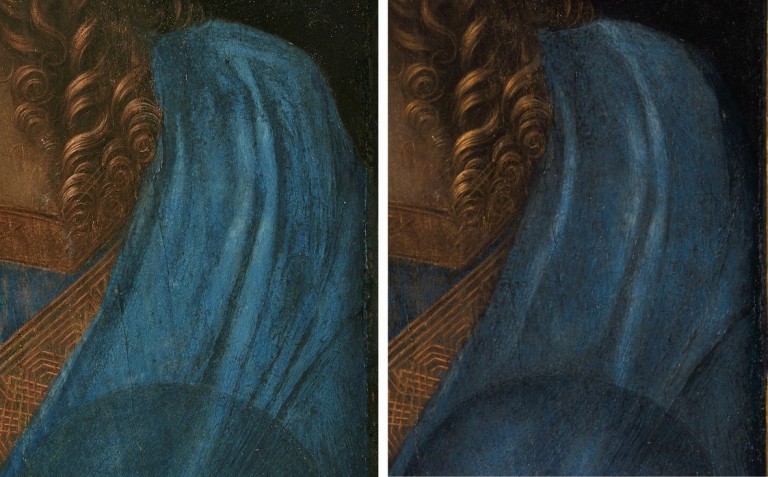
![06 [6] three shoulders (3)](http://artwatch.org.uk/wp-content/uploads/2018/02/06-6-three-shoulders-3-768x388.jpg)
![05 [5] three shoulders (2)](http://artwatch.org.uk/wp-content/uploads/2018/02/05-5-three-shoulders-2-768x322.jpg)
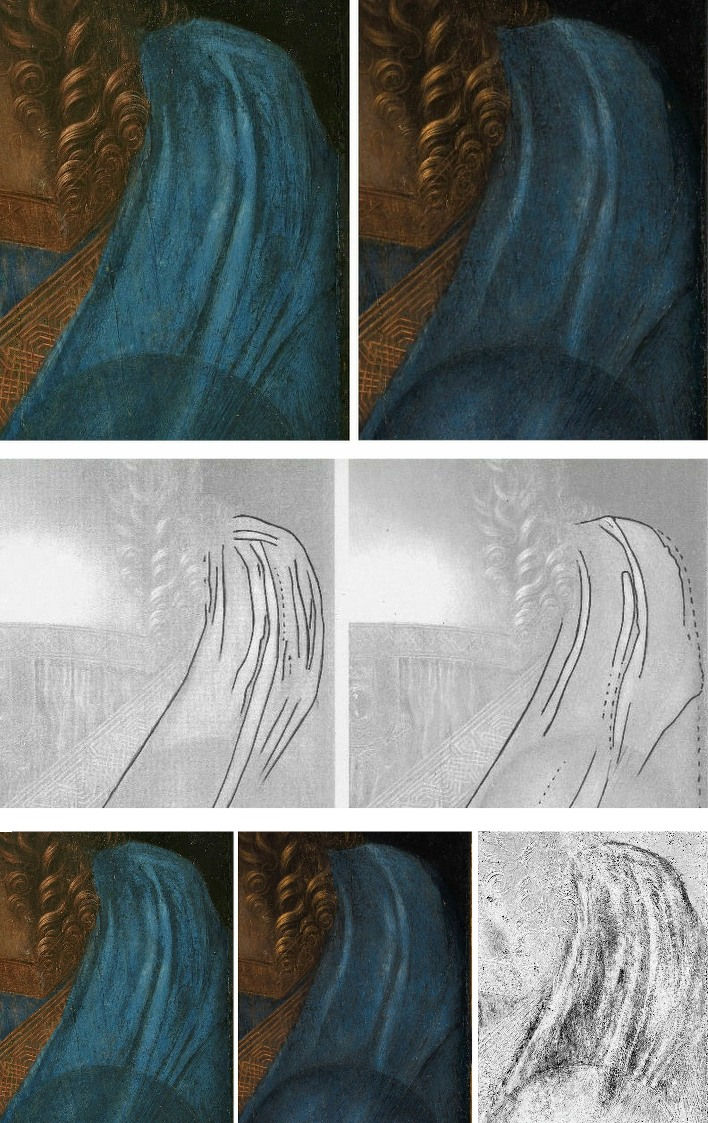

![08 [7] first london outing](http://artwatch.org.uk/wp-content/uploads/2018/02/08-7-first-london-outing-768x1086.jpg)
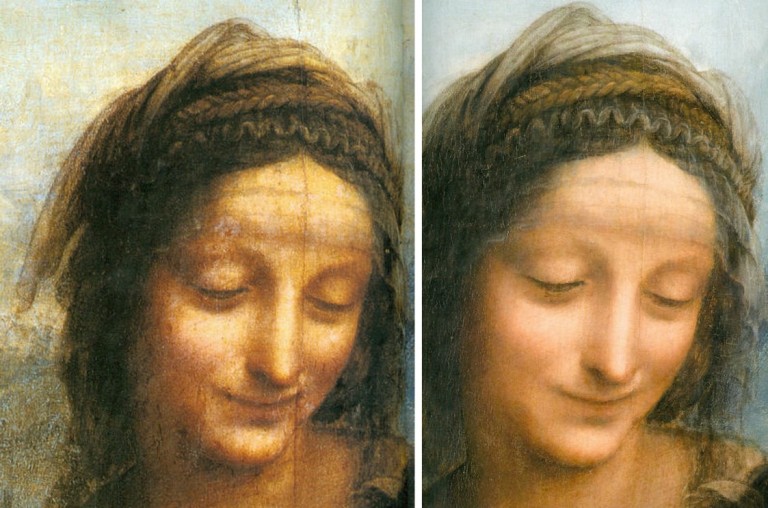
![010 [8] nose jobs](http://artwatch.org.uk/wp-content/uploads/2018/02/010-8-nose-jobs-768x571.jpg)
![11 [9] zzNew Fig. 2](http://artwatch.org.uk/wp-content/uploads/2018/02/11-9-zzNew-Fig.-2-768x1086.jpg)
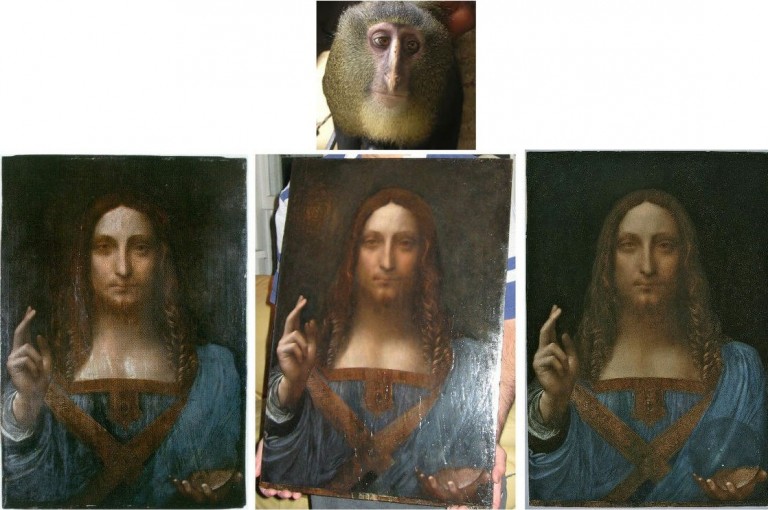
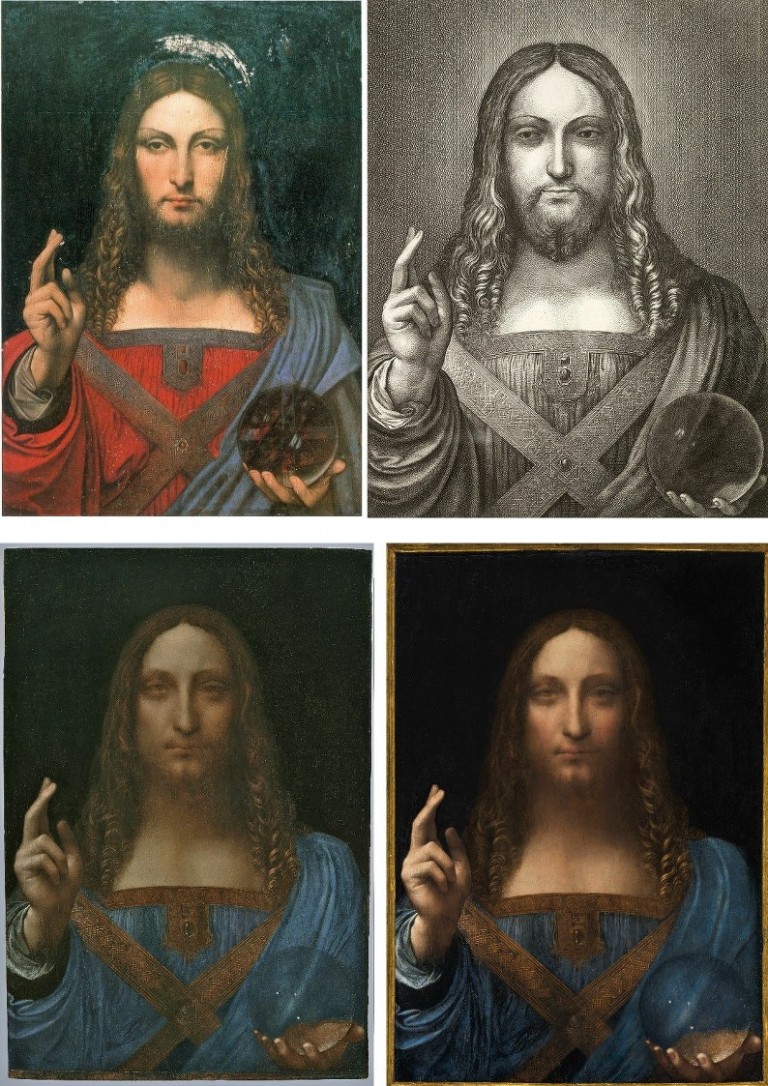

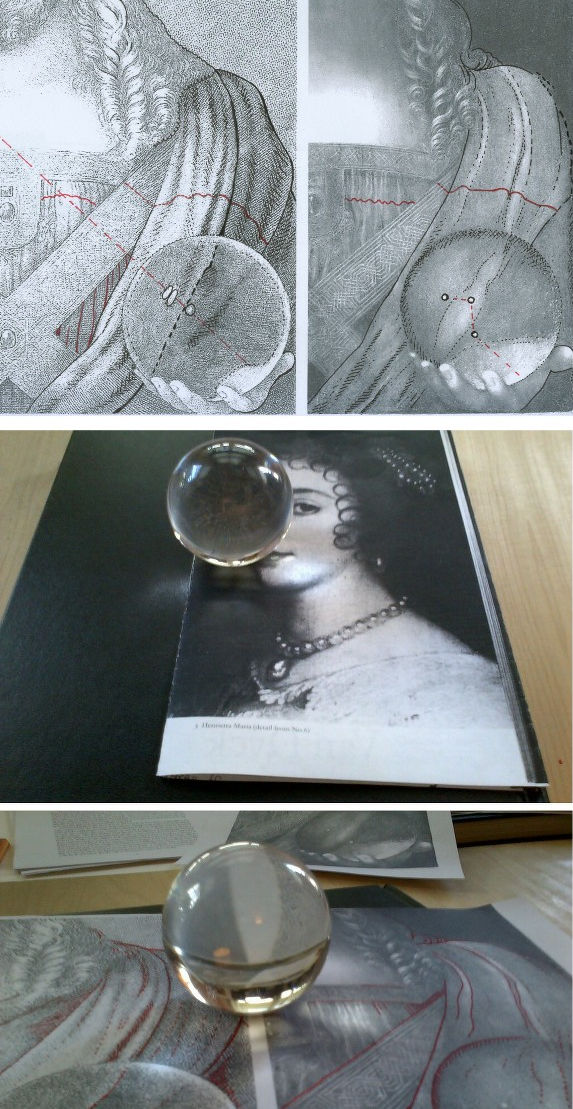

![017 [10] split](http://artwatch.org.uk/wp-content/uploads/2018/02/017-10-split-700x1024.jpg)
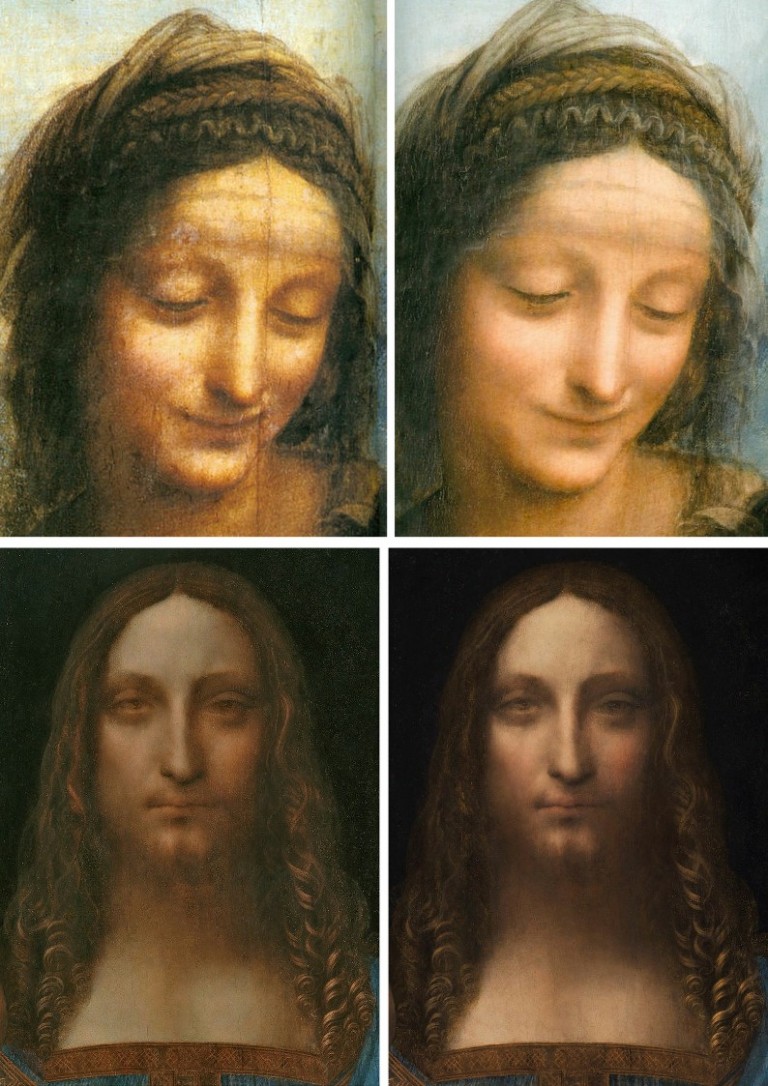
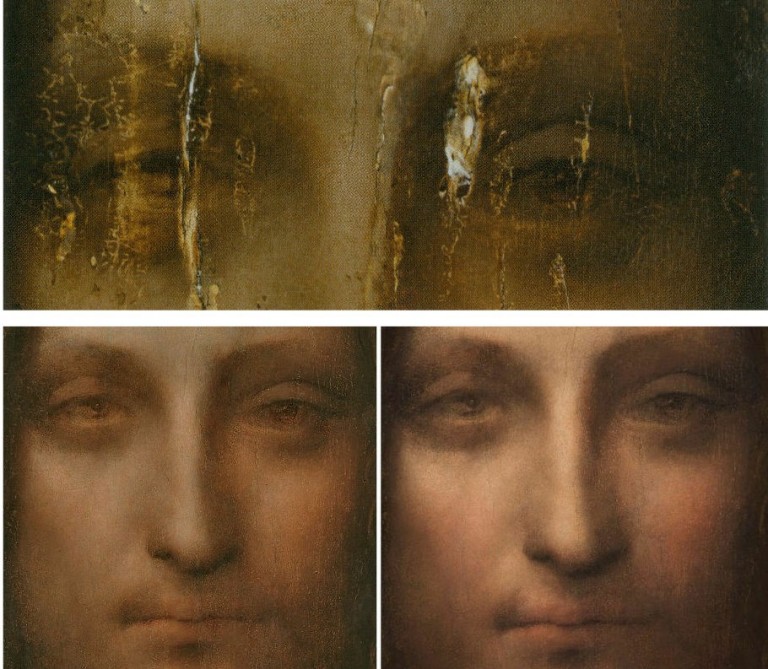
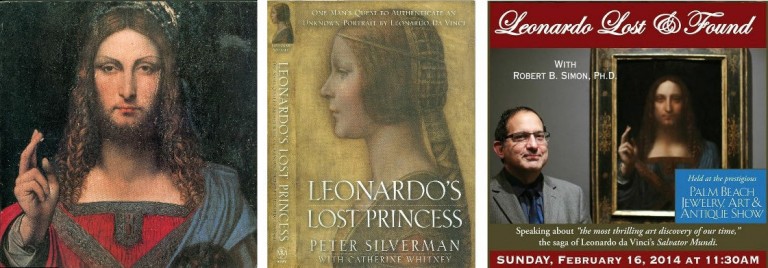
Leave a Reply